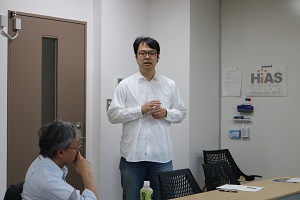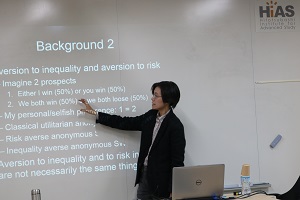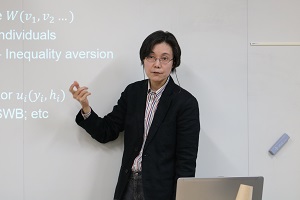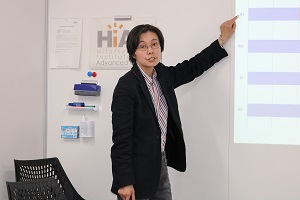HIAS Health invited Prof. Aki Tsuchiya, School of Health and Related Research (ScHARR) and Department of Economics, The University of Sheffield, UK, as a guest speaker and held its 25th regular seminar/Hitotsubashi University International Seminar, on Friday, April 6, 2018. It attracted 15 participants from Hitotsubashi and also other research institutes. They enjoyed lively discussion during the seminar and at the reception dinner with Prof. Tsuchiya.
 |  |  |
| Dr. Ryota Nakamura, Associate Professor, HIAS, introducing the lecturer | Prof. Aki Tsuchiya giving a presentation | Prof. Aki Tsuchiya giving a presentation |
 |  |  |
| Prof. Aki Tsuchiya responding a question | Dr. Shuzo Nishimura, HIAS Health Adjunct Researcher (Director General, Institute for Health Economics and Policy), giving a comment | Group photo of participants |
--------
| Date & time | April 6 (Fri), 2018 16:00-17:30 |
| Venue | HIAS Seminar Room (Faculty Building II, Room 517), Kunitachi West Campus, Hitotsubashi University |
| Speaker | Prof. Aki Tsuchiya, School of Health and Related Research (ScHARR) and Department of Economics, The University of Sheffield, UK |
| Title | “Comparing inequality and risk aversion in social welfare for health and income: an empirical analysis using hypothetical scenarios with losses” |
| Language | English |
| Overview | Conceptually, two kinds of distributional preferences regarding social welfare can be distinguished from each other: inequality aversion and risk aversion. Each of these may depend on the domains of social welfare such as income or health. In this paper, four kinds of distributional preferences are elicited and compared: inequality aversion in health, inequality aversion in income, risk aversion in health, and risk aversion in income. Face to face interviews of a representative sample of the general public in Spain are undertaken using hypothetical scenarios involving losses in health or income across otherwise equal groups, over a limited duration of time. Aversion parameters are estimated assuming Social Welfare Functions with constant relative and constant absolute aversion. We find evidence suggesting that social preferences regarding aversions to inequality and to risk are not the same within the health or the income domain, nor across the two contexts: the results show statistically significant differences among the four distributional preferences, with inequality aversion in household income the strongest, followed by risk aversion in household income and risk aversion in individual health (between which no significant difference was found under constant absolute aversion though), and inequality aversion in individual health coming last. |

